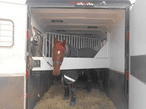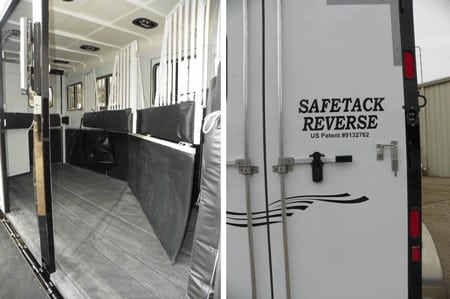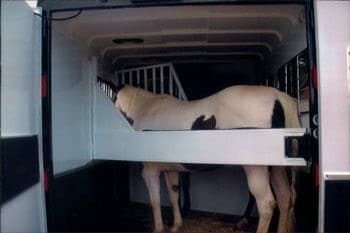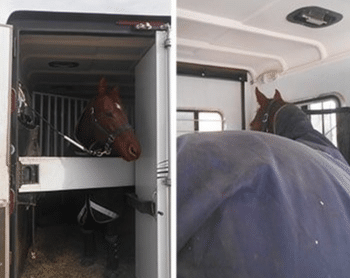Unload Your Horse From the Trailer Without Ever Backing Up Again!
Train Your Horse to Confidently and Safely Unload from the Trailer
Over the years Bonnie has trained more than twenty horses to successfully load and unload from her three horse Four Star aluminum trailer. That’s an especially impressive feat when you consider just how difficult that type of trailer is for loading and unloading. There’s a non-collapsible rear tack area in the back of the trailer that creates a super narrow loading area for the horse. It’s so narrow, in fact, that some people even call those type of trailers “birth canal type trailers.”

Until it didn’t.
When Bonnie bought a four-year-old Lusitano mare, everything changed. Even though she went through the same exact process with her new horse and made sure she felt safe and comfortable around the trailer, this Lusitano mare did something Bonnie’s other horses never did.
One day, while Bonnie was training her, she decided it was time for her first ride in the trailer. So, she shut the door behind her new mare, just like she had done many times earlier while they were training, and set off. She decided just to go for a short drive around the neighborhood, then unload her back at home.
But, after the drive, when Bonnie went to open the back trailer doors, her new mare rocketed out of the trailer backwards! And even though Bonnie kept training, and even asked other trainers for advice, every single time she opened those back doors, her horse recklessly bolted out of the trailer. She could never get her horse to safely unload from the trailer.
This is a common problem for a lot of horse owners. So, we decided to devote an entire article to solving your problem…
Unloading Can Be Very Dangerous for You and Your Horse
Any time your horse is in a high-stress situation, it’s much more likely that they will act out and hurt either themselves or the people around them. Since loading and unloading can be tense moments for your horse, horse owners need to be especially careful during these times.

The unloading situation is especially dangerous for people who own horses that are anxious or nervous around trailers, and for people who own horses like Bonnie’s, who rocket out of the trailer at 100 miles per hour. Often times, when you open the trailer door, the only thing separating your horse from the outside of your trailer is a butt bar or a padded chain – both things that can quickly turn into a hazard for a horse that wants to bail out of the trailer.
And in order to unload your horse, you have to be the person to walk up behind them and unclip the butt bar – putting you in a dangerous position where your horse could run over you or knock you over. For nervous horses that want to bolt out of the trailer as soon as possible, this situation is very high-tension. During moments like these, horse owners lose control of their horses and that puts them in a dangerous and stressful situation.
To keep yourself and your horse safe, it’s always best to remain calm and in control of the unloading process, and to properly train your horse to be more comfortable around the trailer. It’s also important that you understand your horse’s behavior so you can train them more effectively.
Why Does My Horse Always Bail Out of the Trailer?
Horse owners must understand that how they see their horse trailer and how their horse sees the horse trailer are two very different perspectives. While you might see a beautiful, comfortable, state-of-the-art vehicle that will take you to the beautiful countryside or your next competition… your horse sees a scary metal cage.

During time in transit, your horse will be alert – and still in “fight or flight” mode because of this new, unfamiliar experience. Often, trailers are very dark and rattly, and your horse won’t have enough space to turn around and check out the area that he’s in. He’ll jump at the sound of cars honking and his stress will build and build. For many horses, it’s a very scary experience that can cause panic and unusual behaviors.
So, when you stop and open the back door, your horse is already stressed and tense because of the journey. All they can think about is busting out of the trailer as soon as possible. And since horses can’t see directly behind them, when they feel the butt bar unlatch, often they’ll recklessly bolt out of the trailer, putting themselves and you in a dangerous situation.
A Common Mistake Horse Owners Make
Sometimes horse owners spent hours and hours training their horse to get comfortable around the trailer. They use the approach-and-retreat strategy to progressively get their horse closer to the trailer, let him sniff around, and show him that the trailer isn’t anything to be afraid of.
They’ll spend time with their horse in the trailer, and then think that they’ve done it – their horse is all ready to hit the road and travel in their new vehicle. However, one common mistake that horse owners make is spending a lot of time training the horse to load – but no time at all training the horse to unload (2).
“I’ve Gotten My Horse into the Trailer…Now What?”
Equally important to teaching your horse to walk into the trailer is teaching him how to safely exit the trailer. If when the first time your horse steps into the trailer successfully, you don’t know how to help him get out of the trailer, it’s very likely that he will become stressed and anxious and feel trapped.
To avoid this problem, try teaching your horse to back out of the trailer before they are fully inside the trailer. When they have taken a few steps onto the trailer ramp, praise them and reward them, then slowly help them back off the trailer. Show them that you are not the bad guy trying to trap them in the trailer, but rather, the one helping them stay safe and calm.
Just like your horse needs to learn how to load into the trailer with calmness and confidence, it’s also essential that he learns how to unload successfully. Start slowly and let your horse set the pace, and soon you’ll see your horse’s confidence build. Before you know it, you’ll be successfully on the road.
How to Build Your Horse’s Confidence for Unloading
Your horse’s experience the first time they were loaded into and unloaded from a trailer is what they will remember every time they see a trailer. If your horse had a calm, comfortable experience, he will likely be easier to train around the trailer and more willing to enter and exit without stress. However, if your horse was shoved into the trailer or had an otherwise traumatic experience, he will probably have trailer anxiety and be stressed during the loading and unloading process.
However, there are things you can do to train your horse to be confident and calm around the trailer, even if they have had bad experiences in the past.
Slowly Unloading Keeps Your Horse Safe and Happy
Remember that it’s very dangerous for both you and your horse when your horse bolts out of the trailer as soon as you open the trailer doors. This unsafe, rushed unloading style can cause your horse to hit his head or foot on the side of the trailer and lead to pain and injury. To keep your horse safe, a slow, quiet, and calm unloading process is always your best option.
To have a slow and successful unloading process, follow these simple steps.

Easier said than done, right?! An even better solution is to use a trailer where you never need to back your horse off, but we’ll get to that more in just a sec…
You should train your horse to unload multiple times while you are training him to load. Make sure he gets a lot of practice exiting the trailer so that he will feel confident when it comes time to do it for real.
If your horse has a history of bailing out of the trailer or unsafely unloading, make sure you have two people during your training sessions and during unloading. One person will enter the trailer alongside the horse to be near his head and calm him down, while the other person will slowly unlatch the butt bar and work with the other handler to safely help the horse exit the trailer.
Avoid Trailers with Narrow Doorways
Some horse trailers have tack storage areas in the back of the trailer. While these might be convenient for you as a horse owner, they are not really horse-friendly. That’s because the tack area takes up space and makes the doorway where your horse has to load into and exit from even narrower.
If you’re trying to walk your horse into one of these types of trailers, it can be extremely dangerous for both of you. Just imagine if your horse were to get spooked or start to become anxious during loading – if he starts freaking out, you could get thrown into the side of the trailer or pinned against the door frame.
For that reason, it’s important to choose a trailer that has a wide loading and unloading space for your horse. The bigger it is, the less trapped and claustrophobic your horse will feel and the more confidence he will have around the trailer. Plus, the extra space gives you more room to get out of the way if your horse starts to act up. You never want to put yourself in a position where you’ll get pinned against the trailer doorway.
If you really like having a rear tack area in your trailer, you don’t have to sacrifice that just to make the loading process easier. Double D Trailer’s Gooseneck Trailers have a SafeTack design that allows for a full wide door entryway – and a back tack area. The tack area is actually part of the door, and it’s an enclosed tack area, which lets you safely store your tack and have enough room for you and your horse to safely enter and exit the trailer. The entire tack compartment swings out like a second door leaving a wide open area in the back of the trailer for loading and unloading.
Truly, the type of trailer you have can make all the difference when unloading your horse. Some horse trailers are very poorly designed – without adequate light, airflow, and with unreliable materials. These things can make your horse’s loading and unloading experience stressful, dangerous and high-risk.
What if Training Doesn’t Work?
Some horses, because of past trauma or simply their nature, are more anxious and nervous than others. (Cough… my crazy Thoroughbred is a perfect example. You could talk to him and soothe him all you wanted, but when he felt that butt bar drop, he was gone!)
Sometimes, even though you might spend hours and hours training your horse to unload calmly and quietly, they just won’t get it.
That was the case with Bonnie’s four-year-old mare. After the first time she bolted out of the trailer backwards, she kept repeating the same behavior – every time she had to unload her. Once, she even hit the side of the door while rocketing out of the trailer backwards. Because of the unloading accident, she suffered from a hematoma and spent six months healing and recovering.
Bonnie spent months and months trying to train her to back up slowly and calmly. She practiced backing her up over obstacles scattered on the ground, down hills, up hills, and even over railroad ties. She could do all of it in the open pasture – even back up through 30 feet of landscape timbers one foot at a time. But still, Bonnie could never get her to safely back out of the trailer.
A Natural Solution to Unloading Troubles
The backing up action just isn’t normal for horses to do. If you observe wild horses, you’ll see them running, trotting, playing, even rolling on the grass – but not backing up much, and certainly not backing up down an incline like they would do to exit the horse trailer. It’s just not a natural thing for your horse.
That’s why it’s so hard for them to do, and why it can take so long to learn. Horses are animals that are used to roaming free and having lots of space to move around and play – they’re used to moving in a forward motion, not backwards.
But, don’t be discouraged. If you have a horse like Bonnie’s that just won’t back off the horse trailer successfully, there is a solution.
It’s simple – just don’t make your horse back off the trailer. Let him walk off naturally, and you’ll avoid so many of the problems horse owners face when they unload their horses from their trailers backward.
Two Simple Solutions to the Dangers of Unloading
You can avoid the hassle of unloading your horse backwards entirely with a reverse load horse trailer. Trailers like these are specifically designed with your horse’s natural instincts in mind. They make the loading and unloading process much easier and much more enjoyable for both your horse and you.
In fact, the patented SafeTack Reverse Load design that Double D Trailers uses includes two simple solutions to the dangers of traditional unloading techniques – a final stall divider to protect your horse from bolting out of the trailer while you are unprepared, and the rear facing travel style.
Why Your Trailer Needs a Final Stall Divider

Brad Heath, owner of Double D Trailers, says that “most slant load trailers are built with a partition to separate your horses from each other, but don’t have anything to secure the horse in the most rearward stall. If you put a panicky horse in that stall, often he’ll try to bolt out as soon as the doors open. And the weak strap or bar that’s between him and the outside can become a safety hazard.”
Double D Trailers has come up with a safer solution – in all of our trailers, there’s a final full-sized partition that keeps your horse securely in the trailer, even when you open up the back doors. That way, you can easily walk up to your horse and untie them while they are still securely inside the trailer – you won’t have to worry that your horse will bolt out the trailer.
When you are ready to unload, all you have to do is release the final divider and help your horse slowly and calmly exit the trailer. With this unique design you are never in a position where your horse could get spooked and kick you. The final stall divider works to keep both of you safe and protected.
Completely Avoid Backwards Unloading!
Having your horse back out of the trailer backwards is unnatural, stressful, and dangerous. With the unique design of Double D Trailers, you can avoid backwards unloading entirely.

The SafeTack reverse trailers also have a great option that makes it even easier to unload your horses – rear facing configurations. Facing your horse rearward while trailering makes it possible for them to walk onto the trailer normally using a side loading ramp, and walk off the trailer normally use the rear doorway.
You can load your horses through the side access door and loading ramp, then unload through the back door – and your horse will never have to back up during the entire process.
Reread that last sentence… your horse will never have to back up ever again!
With all types of SafeTack trailers, your horse will never have to back out of the trailer to unload. Instead, he’ll be able to calmly and safely exit the trailer walking like he’s used to. This eliminates much of the stress that your horse faces while loading and unloading, and many of the safety hazards that owners and handlers face as well.
Truly, a “horse-friendly” trailer can make all the difference when it comes to you and your horse’s safety and protection during the unloading and loading process. With SafeTack trailers, your horse can travel confidently, and be just as excited as you are to arrive at your final destination.
Avoid the Headache – Walk Your Horse Off the Back of Your Trailer

One of the easiest ways to solve loading and unloading problems is with a SafeTack reverse trailer. In these types of trailers, your horse can either ride forward-facing or backwards. It might seem odd that your horse would want to ride backwards, since as humans we’re used to facing in the direction we are going, but it’s actually a very natural transportation position for your horse.
In fact, researchers have even studied horse behavior in trailers during transport and found that most of them prefer the backwards-facing position. In their research, they observed horses that were free to move around in a moving trailer without partitions and found that most of them chose to ride in the rear-facing position.
The rear-facing position not only makes it easier for you to unload and load your horse, but it’s also much better for your horse both physically and emotionally. Putting your horse in the rear facing position while traveling reduces injuries and helps them arrive fresher physically and calmer emotionally.
Check out this customer video of a horse being loaded and unloaded in a Safetack Reverse horse trailer.
Horses Have Fewer Injuries When Riding Backwards
As it turns out, reverse facing trailers help prevent horse injuries. One study showed that when horses are trailered facing away from the direction of travel, they have fewer falls and they bump into the dividing partitions less (4).

They also found that horses that faced backwards during transit arrived “considerably fresher” compared to those that were forward-facing. The horses that were transported forward-facing suffered from muscular and emotional stress, likely because their center of balance was unnatural and stressed.
Bonnie’s Experience Unloading from a Double D Trailer
After months and months of trying to train her new mare to unload from her old trailer, Bonnie decided to buy a new one. She realized that her safety and her horse’s safety was what was most important to her, and decided to try a SafeTack Reverse 3 Horse Gooseneck Trailer. It has a double wide side ramp that her horse can walk into from the side and go right to the rear-facing stall. Then, when they arrive at their destination, her horses can just walk right out the back doors and out of the trailer.

When Bonnie took her Lusitano mare to the trailer for the first time, she wondered how her horse would react to the new trailer. As Bonnie led her to the trailer, her young mare was calm and relaxed. She walked in with her through the side door, practiced moving around the stall dividers, and walked her down and out the trailer.
Her horse, that used to bolt out of the trailer in a stressed mess every single time, was calm and comfortable. Bonnie said, “she adjusted to the new trailer immediately. It was just amazing!” Her horse’s transformation from anxious and stressed to calm and confident is incredible, and has happened for more horses than one. The Reverse Load Trailer eliminates the need to back up, eliminating all the stress and panic that comes from a backwards unloading process. For Bonnie and her horse, the SafeTack loading design changed the unloading process completely.
Now Unloading is as “Smooth as Silk”

Bonnie’s 3 horse slant load trailer, instead of having a dangerous butt bar or chain, has a full-sized final stall partition that keeps her mare in the trailer, even when she opens up the trailer doors. That way, she can calmly and easily untie her horse’s halter and secure a lead line before starting the unloading process.
She said, “the way they have the last divider designed, along with the placement of it, and the size of it… it’s just perfect. A horse is not going to try to bust through it. So, I just think that's brilliant.” It’s sturdy and strong, and built to keep even the most bolt-prone horses inside the trailer until you’re ready to unload.

Every single Double D Trailer is made to order, specifically and uniquely for people like Bonnie, and for people like you. You can customize the design to make your trailer just right for you and your horses – adding things like increased head room, a specialized tack area, and your choice of exterior design and colors. And, no matter where you live in the country, we’ll deliver it right to your door for just $395.
Forget about the dangers and hassles of unloading your horses backwards from your trailer. Try out our “walk on walk off” loading and unloading system today, and your horse will thank you forever. Reach out to Brad Heath for more information or start designing your own custom SafeTack Reverse Load trailer today.
References:

